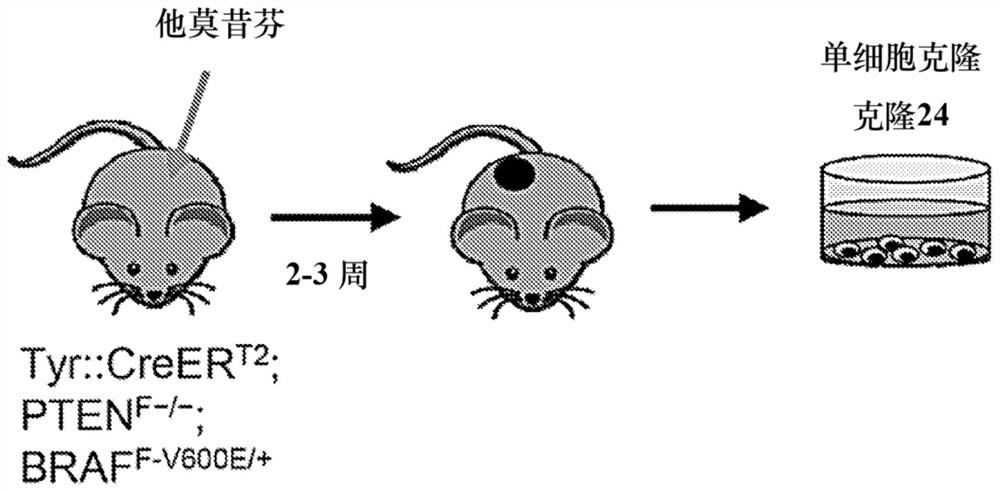Expression of metabolic modulators in tumor microenvironment to improve tumor therapy
A metabolic regulation and tumor technology, applied in anti-tumor drugs, microorganisms, medical preparations containing active ingredients, etc., can solve the problem that leptin has not been confirmed in treatment
- Summary
- Abstract
- Description
- Claims
- Application Information
AI Technical Summary
Problems solved by technology
Method used
Image
Examples
Embodiment 1
[0154] Materials and methods
[0155] This example describes the materials and methods used to produce the results described in the following examples.
[0156] mouse
[0157] C57 / BL6 mice and Pten f / f Braf V600E Tyr Cre.ER Mice were obtained from Jackson Laboratories and bred in house.
[0158] tumor line
[0159] Use of Pten derived from coated with tamoxifen f / f Braf V600E Tyr Cre.ER A single cell clone of the formed melanoma tumor was used for tumor experiments (clone 24). The cDNA for leptin was obtained from OriGene and transfected into clone 24, followed by hygromycin selection (an empty vector plasmid was used as a control). Single-cell clones were selected and grown into the cell line CL24 for the control plasmid 潮霉素 and the cell line CL24 for expression of leptin 瘦素 .
[0160] tumor model
[0161] Injection of CL24 into C57BL / 6J mice on day 0 潮霉素 or CL24 瘦素 Melanoma cell lines (250,000 cells intradermally), then until tumors reach 15 mm in any ...
Embodiment 2
[0179] Treatment of tumors with oncolytic vaccinia virus remodels the tumor immune microenvironment
[0180] Although oncolytic viruses such as T-vec are FDA-approved immunotherapies for cancer treatment (see for example Andtbacka et al., J Clin Oncol 2015;33(25):2780-8), the immune consequences of these drugs still not clear. Systematic analysis of immune infiltration induced by oncolytic virus infection. A major limitation of oncolytic virotherapy is that many viruses, including T-VEC, cannot replicate efficiently in hypoxic conditions (Friedman et al., Transl Oncol 2012;5(3):200-7; Pipiya et al., Gene Ther 2005;12(11):911-7). Therefore, an oncolytic vaccinia virus that is easily engineered, encodes its own polymerase and maintains replicative function in hypoxic tumor cells was used. The Western Reserve laboratory strain of vaccinia virus was used. The virus has a genetic deletion of the thymidine kinase and vaccinia growth factor genes, resulting in a potent oncolytic ...
Embodiment 3
[0183] Oncolytic vaccinia virus promotes infiltration of severely metabolically deficient T cells
[0184] Flow cytometric analysis of TILs from oncolytic virus-treated mice confirmed that the influx of new immune cells appears to be regulated by CD8 + T cell control, whereas we observed a decrease in T regulatory T cells ( Figure 4A ). Analysis of the expression of co-suppressive markers in these cells revealed that only Tim3 ( Figure 4B ) and CD8 with low to moderate expression of PD1 (Panel C) + The influx of T cells suggests that these cells are not reactivated tumor residents, but rather newly infiltrated and not completely depleted of T cells. Metabolic insufficiency is also predictive of T cell function, although the expression of co-repressive molecules is associated with T cell dysfunction. analyzed mitochondrial content as a marker of metabolic adequacy, revealing that despite the expression of 'non-exhaustive' co-repressive molecular patterns, TILs in oncolyti...
PUM
 Login to View More
Login to View More Abstract
Description
Claims
Application Information
 Login to View More
Login to View More - Generate Ideas
- Intellectual Property
- Life Sciences
- Materials
- Tech Scout
- Unparalleled Data Quality
- Higher Quality Content
- 60% Fewer Hallucinations
Browse by: Latest US Patents, China's latest patents, Technical Efficacy Thesaurus, Application Domain, Technology Topic, Popular Technical Reports.
© 2025 PatSnap. All rights reserved.Legal|Privacy policy|Modern Slavery Act Transparency Statement|Sitemap|About US| Contact US: help@patsnap.com



